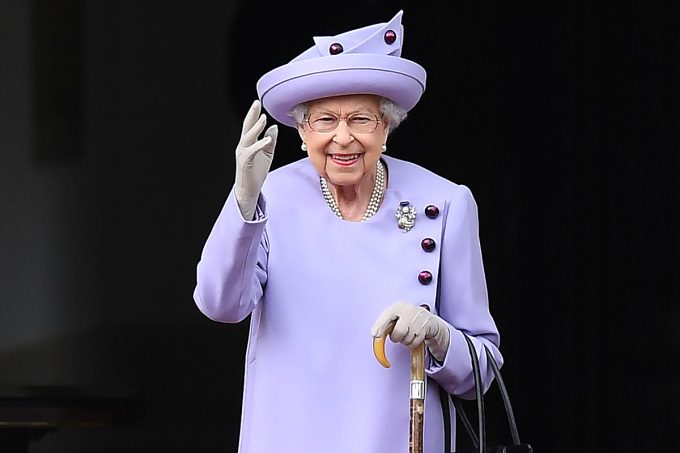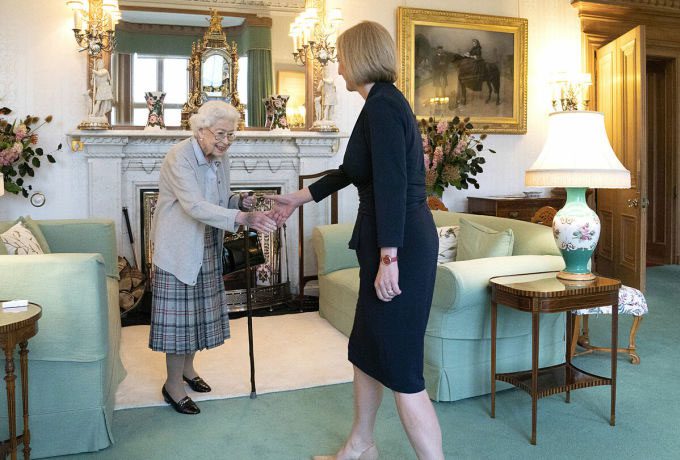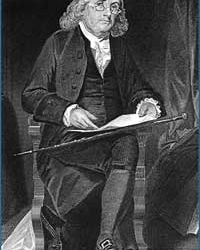Buckingham Palace announced the passing of Queen Elizabeth II of the United Kingdom at Balmoral Castle in Scotland on September 8, at the age of 96.
“The Queen passed away peacefully at Balmoral this afternoon. The King and Queen will remain at Balmoral tonight and return to London tomorrow,” Buckingham Palace announced at 6:30 PM on September 8 (12:30 AM on September 9, Hanoi time).
Prince Charles, 73, who has been the designated heir to the throne since the age of three, has now become King Charles III and will be officially proclaimed at St James’s Palace in London as soon as possible.

Queen Elizabeth II at the Palace of Holyroodhouse in Edinburgh, Scotland in June. (Photo: AFP).
The announcement came just hours after Buckingham Palace stated that doctors were concerned about the Queen’s health and that she needed medical supervision. All of the Queen’s children, including Prince Charles, Princess Anne, 72, Prince Andrew, 62, and Prince Edward, 58, immediately traveled to Balmoral to be by her side. Her grandson, Prince William, was also present.
The United Kingdom will observe a national mourning period of 10 days to honor the Queen.
As Queen of the United Kingdom and head of the Commonwealth of 54 nations, Queen Elizabeth II was the world’s most recognized head of state with an exceptionally long reign.
Queen Elizabeth II ascended to the throne in 1952 at the age of 25, following the death of her father, King George VI. In June, the United Kingdom celebrated the Platinum Jubilee marking her 70 years on the throne, longer than any other monarch in the country’s history. Her husband, Prince Philip, passed away in April 2021 at the age of 99.
The Queen’s health had been under scrutiny since she spent a night in the hospital last October for an undisclosed illness, after which doctors advised her to rest. That same month, the Queen also drew attention for using a cane in public for the first time since 2004. Since then, she has limited her public appearances.
In February, the Queen was confirmed to have contracted COVID-19, raising concerns due to her being in a high-risk group. Buckingham Palace at that time reported that she only exhibited mild flu-like symptoms, but the Queen later shared that she felt fatigued and exhausted due to the virus.
By May, Queen Elizabeth did not attend the State Opening of Parliament for the first time in nearly 60 years due to mobility issues.
Concerns about the Queen’s health escalated when she withdrew from a virtual meeting with newly appointed government ministers on September 7, after doctors advised her to rest. Just a day earlier, the Queen had welcomed the new Prime Minister of the United Kingdom, Liz Truss, and officially appointed her.
In the appointment photos, the Queen smiled but appeared frail and was using a cane. One photo raised alarm as it showed a significant bruise on her right hand.

Queen Elizabeth II (left) welcoming new Prime Minister Liz Truss at Balmoral Castle in Scotland on September 6. (Photo: AFP).
Television and radio stations interrupted their regular programming to broadcast news of the Queen’s death, with special schedules that had been rehearsed for a long time to commemorate her life and long reign. The national anthem “God Save the Queen” was played. Flags were lowered and church bells rang in memory of the Queen.
For most people in the United Kingdom, Queen Elizabeth was the only monarch they had ever known, an unchanging figure on stamps, banknotes, and coins. With her petite stature yet as a symbol of popular culture, she always stood out in vibrant outfits paired with matching hats, pearls, gloves, and handbags.
Her reign spanned many changes in the world, from the Cold War to the September 11 attacks, from climate change to the COVID-19 pandemic, from handwritten letters and steam trains to emails and space exploration. She was seen as a living embodiment of post-war Britain and a link between the modern era and the past.
As the head of one of the world’s most famous families, she enjoyed tremendous public support throughout her life, even facing backlash after the death of Princess Diana in 1997.
More recently, the British Royal Family was shaken by claims from Prince Harry and his wife Meghan about racism within the monarchy. She also endured a scandal involving her second son, Prince Andrew, a friend of convicted sex offender Jeffrey Epstein.
The British public was stunned to realize that her reign would come to an end following the Queen’s loss of her beloved husband. However, the royal family had long prepared for the scenario of the Queen’s passing, and the process for Prince Charles’s succession was already underway.
King Charles III, his eldest son Prince William, who is now the heir apparent, and his wife, Princess Kate, will begin to assume more responsibilities from now on.
- Incredible Privileges of Being… the Queen of England
- Why Doesn’t the Queen Use Her Last Name?
- The Meaning Behind the Queen’s Iconic Wave
- Double Rainbow Appears Outside Buckingham Palace as the Queen Passes
- Prince Charles Becomes King of the United Kingdom
- The Succession Process of King Charles III After the Queen’s Passing





















































